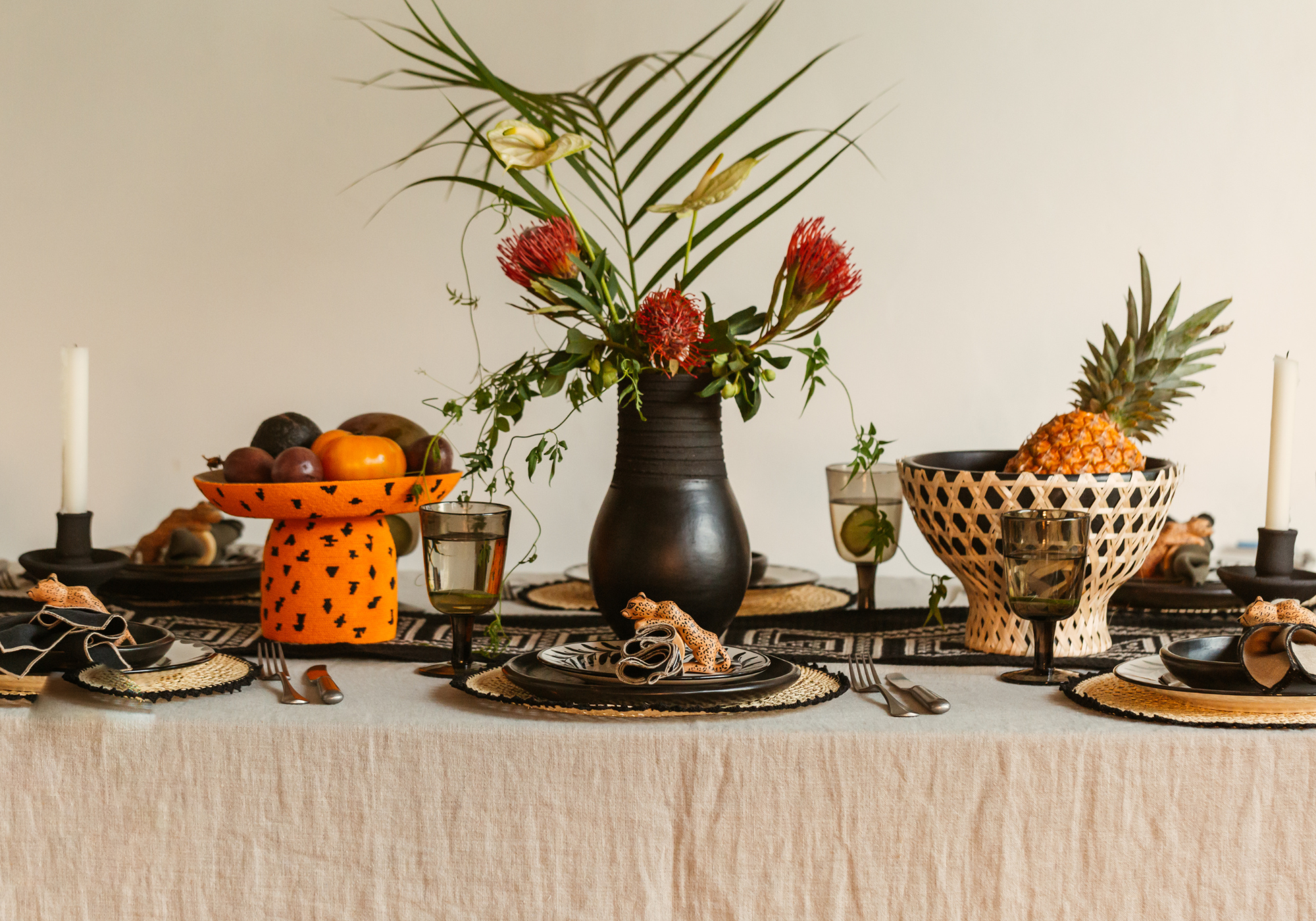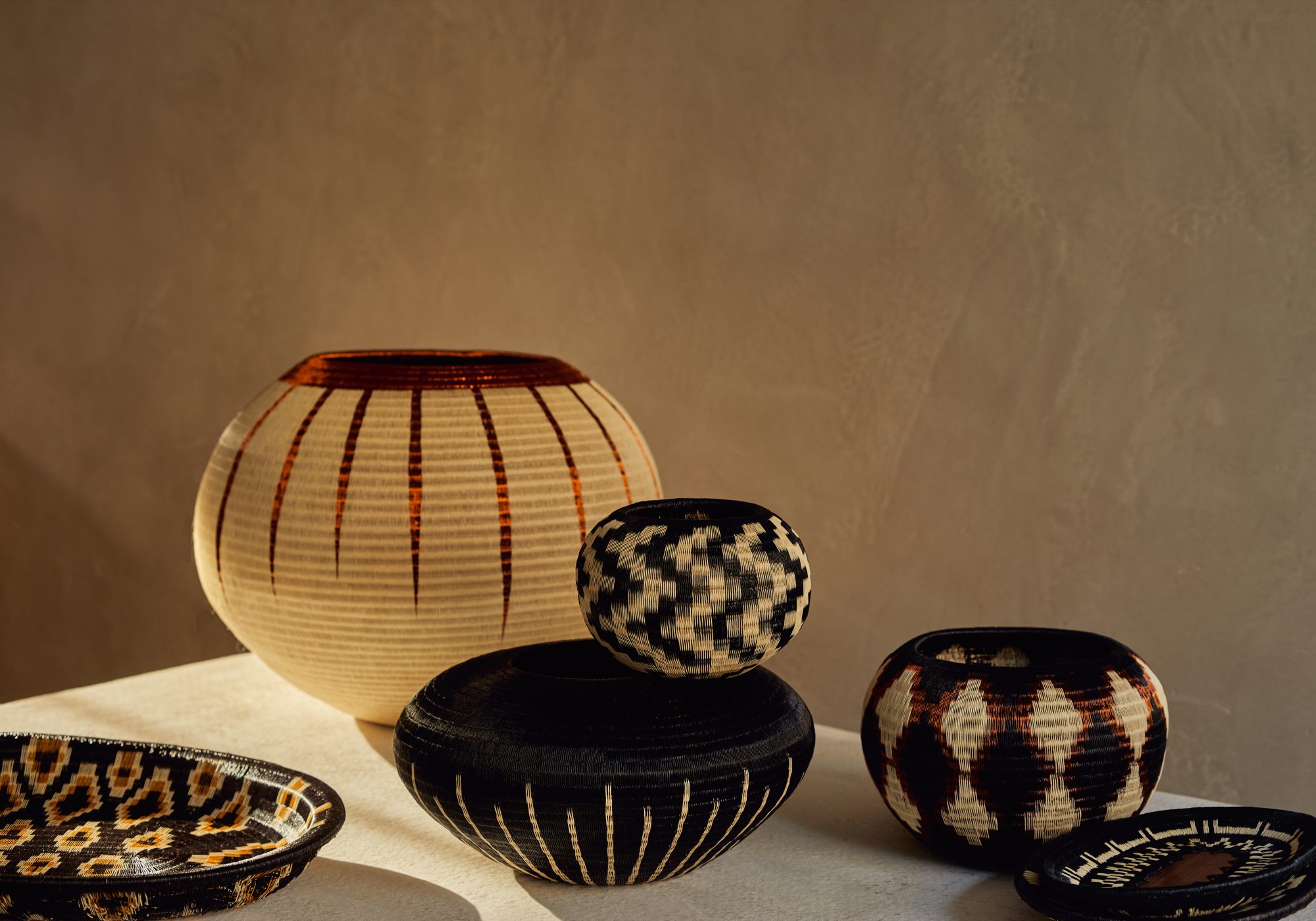Our Makers
The beating heart of CasaLatina are our makers. We work directly with over 60 artisans in nine communities across Colombia and Venezuela, each one a master of an ancestral technique of great cultural significance.

Tolima
The Potters of La Chamba
Each piece of this iconic black clay pottery is crafted using a traditional process that dates back centuries, lovingly fashioned by generations of families in the quaint village of La Chamba, Colombia.
These vessels are made using only local micaceous clay, harvested straight from the banks of the Magdalena River, shaped by hand and fire-cured on-site to achieve the signature black finish that sets Chamba Pottery apart from the rest.

El Chocó
The Wounaan Werregue Weavers
The weavers of the Wounaan community in Colombia, are located in the Pacific region bordering Panamá, known for its lush tropical rainforests, rivers, and vibrant biodiversity, which provides the backdrop for these artisans' remarkable craft.
The Wounaan people, have a deep-rooted cultural connection to the land and have held the tradition of weaving with Werregue palms for generations. Skilled artisans use thin strips of Werregue palm leaves to meticulously craft intricate baskets. Passed down through generations, this traditional technique represents more than just a craft—it serves as a cultural treasure, embodying the history, wisdom, and deep connection to nature that the Wounaan people hold dear. Each basket tells a story, often showcasing geometric designs and vibrant colours that reflect scenes from Wounaan cosmology and legends. As these beautifully woven baskets make their way into the global market, they not only support the socio-economic development of the community but also serve as a bridge for cultural exchange.

Nariño
The Weavers of Sandoná
On the mountainous Southwest region of Colombia, lies the market town of Sandoná, where weaving traditions have a rich history that spans many centuries. The town has become renowned for its skilled artisans who have mastered the art of weaving using the Iraca Palm. This tradition has been passed down through generations of women, who gather in shared spaces to work together.
Their intricate weaving technique requires great skill and precision, it results in a tight, flexible and durable weave that is used in hats, baskets and home decor items and valued by many high end designers the world over.

Putumayo
The Kamentsa e Inga Woodworkers
In the remote landscapes of Putumayo, Colombia, live the Kamëntsá and Inga community, one of the most remote indigenous communities in the country. Known for their remarkable woodworking and bead veneering techniques, the artisan of the community produces visually captivating works of art that also serves as a link to their history and cultural heritage. Each bead holds deep meaning, reflecting their ancestral wisdom and spiritual connections.
The artisans of Kamëntsá and Inga carve elaborate pieces out of local fallen trees that are soaked in rainwater to soften them. By employing both traditional methods and modern materials like Shaquiras (tiny beads), they create stunning woodwork adorned with intricate geometric patterns. This craft is more than an artistic expression; it is a testament to their traditional culture with each colour and pattern holding an ancestral meaning deeply rooted in ancient rituals and ceremonies. These artisans stand as guardians of their traditional knowledge, preserving their ancestry and storytelling through the striking beauty of their artwork.

Atlantico
The Potters of Ponedera
In the town of Ponedera, along the scenic banks of the Magdalena River, a community of skilled potters has been moulding white clay into art for generations. Inspired by the patterns of the Magdalena river turtle, their traditional shapes and decorations have stood the test of time. Recently, a cooperative called Arcillas de Puerto Alegre has formed, bringing together 12 local families and improving working conditions. With the support of the local government, they have installed a state-of-the-art communal oven, elevating the quality of their pottery. Additionally, by experimenting with tinted clay, they have created mesmerising marbled effects on their pieces. This revitalisation of interest in their art not only supports the community's livelihood but also preserves the cultural heritage of Ponedera.
The pottery of Ponedera represents a tangible connection to the town's identity. The potters' dedication to their craft tells a story of resilience and a deep connection to the land and river. In this tranquil oasis, the potters of Ponedera continue to shape clay into art, honouring the past, embracing the present, and shaping the future of their cherished ceramic tradition.

Atlantico
The Iraca Weavers of Usiacurí
Nestled in the coastal village of Usiacurí, Colombia, the skilled iraca weavers create intricate works of art using fibres from the iraca palm. Their handmade pieces showcase a blend of tradition and innovation, reflecting the community's deep cultural heritage. From baskets to accessories, each item tells a story, preserving rituals, legends, and beliefs that have been passed down through generations.
A distinctive element of the iraca weavers' craft in Usiacurí is the use of rigid metal frames, crafted by local blacksmiths. These frames are utilised as a foundation for the iraca palm fibres to be woven around, enabling the weavers to create intricate shapes and structures. This technique brings a level of precision and innovation to their artistry that sets it apart from other weaving techniques.
We are proud to partner with Artesanías del Atlántico, a private/public organisation dedicated to supporting the artisan community in Usiacurí. This collaboration aims to enhance the commercial capabilities of the weavers, enabling them to reach a wider audience and gain greater economic opportunities. By working alongside Artesanías del Atlántico, we are collectively supporting the preservation of traditional craftsmanship while empowering the community to thrive in a global market.

Lara
The Woodworkers of Guadalupe
The woodworkers of Guadalupe, located in the heart of Lara, Venezuela, are known for their craftsmanship and unparalleled skill. The lush hills of Lara, where a wide variety of trees grow in abundance, provide locals the raw materials for their craft. The quaint Plaza Bolivar, in the centre of town, is surrounded by small shops where local artisans sell their wares. The woodworkers of Guadalupe employ traditional techniques such as wood carvings and wood inlay, carefully selecting locally sourced wood in different colours like light oak, dark ebony, red carob, and streaked Verawood. Beyond their aesthetic value, these woodcarvings have a rich cultural significance in the region. The tradition of wood carving dates back to colonial times, where local wood was used to craft religious figures for churches and cathedrals around the country. Over time, the techniques were expanded to craft utensils, boxes, trays, and famously decorative wooden fruits.
Today, the woodworkers of Guadalupe continue to carry on this important tradition, preserving their cultural heritage through their craft. The region's woodworkers are truly a treasure of Venezuela, demonstrating their mastery of the craft with each handmade piece.

Antioquia
The Ceramic Artists of Carmen del Viboral
Nestled in Colombia's Carmen del Viboral, just a stone's throw from Medellín, a vibrant community of ceramic artists thrives. Dating back to the 19th century, it has become the heart of Colombia's ceramic industry. Using materials sourced from the region's own rich deposits of feldspar and quartz, the base pieces (bizcocho) are made in local workshops and decorated by hand in the many studios in town.
The ceramic painting techniques of Carmen del Viboral are steeped in tradition and ancestral knowledge, passed down through generations. Each stroke and brushstroke tells a tale of cultural significance. The designs found on these hand-painted ceramic creations carry the indelible marks of indigenous and Spanish craftsmanship, embodying the unique blend of cultural heritage that defines the region. Furthermore, each piece is painted freehand, without relying on stencils or templates. It is a true testament to the artists' exceptional talent and passion.

El Cauca
The Esperara Siapidara Weavers
The "Paja Tetera" is revered material within the "Eperara Siapidara" indigenous community, located in the Cauca region, owing to its unique quality that enables its transformation into everyday items such as plates and baskets. This remarkable material has been utilised in the creation of a variety of visually striking objects that are not only functional but also highly regarded as art pieces.
We collaborate with the MITES group, comprised of five families originally from Timbiquí, who now reside in the south of Bogotá due to forced relocation. From a tender age, they learned their craft watching their grandmothers and mothers skilfully weaving in their everyday lives. This significant tradition is perpetuated through the passage of time, from one generation to the next, representing an invaluable cultural heritage.
"The artisan is a silent poet who expresses their imagination in each creation"
– diego Rivera



